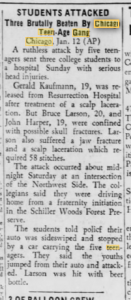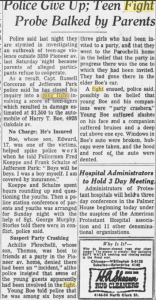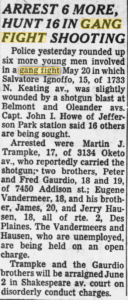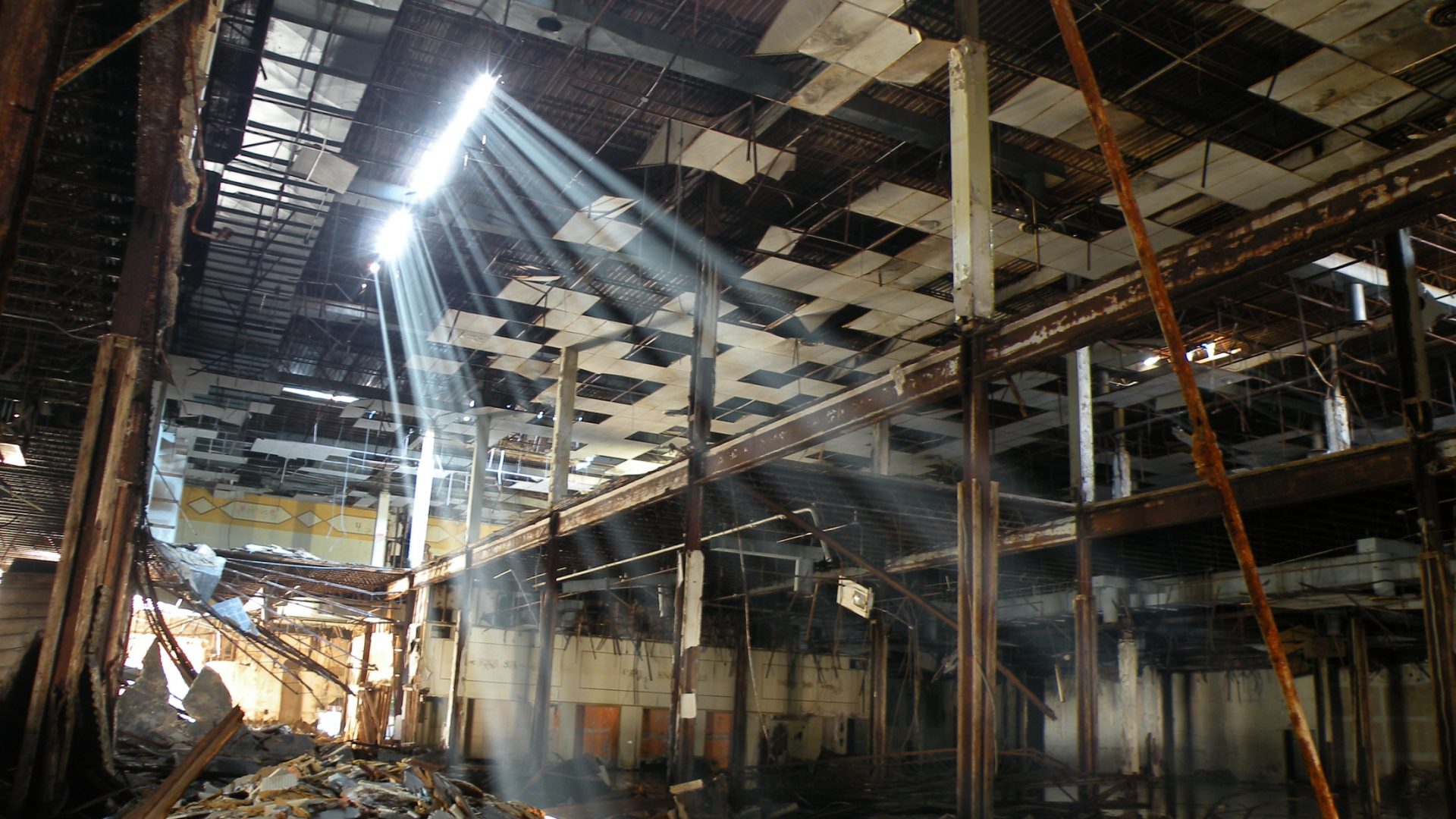| Origins | Settled by Peter Ludby in 1839 and annexed c. 1889 |
|---|---|
| Area | Northwest Side |
| Boundaries | Irving Park Road up Narragansett to Montrose to West Forest Preserve Ave on the north, Belmont down Harlem to Wellington then up 76th back to Belmont on the south, Austin Ave to Irving Park then back up to Narragansett on the east, Cumberland Ave on the west |
| Gangs headquartered | Spanish Gangster Disciples, C-Notes, |
These lands were settled in the year 1839 by Peter Lubdy who built a farm on this land and farmed it very well. In the year 1851, Lubdy was approached by Cook County officials with a plan to buy his land to build a “poor farm” which would be a three-story building that would house many of Chicago’s homeless population and at this location many of the homeless could work to grow crops. The building was completed in 1854. This was also a school for homeless children. This building was situated in the far northern part of the neighborhood from Montrose to Irving Park Road, Narragansett to Oak Park Ave. In the year 1863 tuberculosis patient treatment was added to this building as sick people could be housed here as well. (Fact source, http://www.encyclopedia.chicagohistory.org/pages/395.html)
Right after the Civil War Andrew Dunning had an idea to build a nursery and start a village with 120 acres he just purchased just south of the poor farm; however, this was not a popular idea since the poor farm was to get an insane asylum building on the same land. The County Insane Asylum and Infirmary opened in 1869. This insane asylum plans deterred people from wanting to reside on these lands. There would be multiple buildings to house over 1,000 insane patients, this was not ideal for people to live nearby. The Area also had terrible public transit even for visitors to the asylum as they would have to journey on foot for two and half miles from the train depot just to visit loved ones. This was finally resolved in 1882 when the Chicago, Milwaukee & St. Paul rail company laid tracks leading much closer to the asylum that was nicknamed “Crazy Train.” (Fact source, http://www.encyclopedia.chicagohistory.org/pages/395.html)
The insane asylum developed a bad reputation in the 1880s and 1890s as brutal place for patients. In the year 1886, an investigation found minimal heat in the winter, no hot water and poor ventilation that led to patient illness then death. Investigators also discovered employees were abusing patients, gambling and were guilty of other misconduct. The asylum also hired underqualified yet favored medical staff which was a recipe for disaster. (Fact source, http://www.encyclopedia.chicagohistory.org/pages/395.html)
Brutal conditions of the asylum didn’t help this area to become fully settled. The area remained barren as only random farmers settled on these lands and no village was built. The area got a little spark when Henry James Kolze inherited land and a tavern in the vicinity of Irving Park and Narragansett right across from the asylum and built Kolze’s Electric Park in the year 1896. Kolze converted the two-story inn that featured a hotel, restaurant and tavern aimed at accommodating visitors of the local Mount Olive Cemetery that was built in 1886 and visitors of the insane asylum. He made this possible because in the same year of 1896 the Irving Park Boulevard Street railway laid tracks that could transport visitors with ease here as an alterative to the crazy train. He took it a step further in the year 1905 by building a picnic grove behind the tavern that featured large gas lamps that lit the park up at night which was one of the first lit up parks in Chicago area. This allowed night time activity as shooting gallery, dancing pavilion and concession stands. This was the beginning of interest in the area as the park distracted people from the horrors of the asylum. (Fact source, http://www.encyclopedia.chicagohistory.org/pages/395.html) (https://drloihjournal.blogspot.com/2017/10/kolzes-electric-park-chicago-illinois.html)
In the year 1910, relief came when the poor farm closed and moved out of the area. In 1912, the asylum was purchased by the state of Illinois and became Chicago-Read Mental Health Center. The legacy of horror now shifted to the state after a headless body was found that “drowned to death” and several dead patient bodies were buried in back of the asylum. Once the state ran the facility it was still hellhole but just a more organized hell hole that thrived until 1988. (Fact source, http://www.encyclopedia.chicagohistory.org/pages/395.html). Regardless of the change the name “Dunning” was associated with horror that terrified people to even mention the name.
In the year 1916, Schorsch Brothers Real Estate came to Dunning to create the very first subdivision west of Austin Ave that would be called West Portage Park to not associate with the horrors of “Dunning.” Right after the first world war Swedish, Polish and German migrants settled on these lands. In the year 1934 the adding of Wilber Wright Junior College was built near the insane asylum which added more to this area and the population would continue to grow. In the late 1940s the electric park closed and as of 1950 was to be replaced as a city park. Work on this park would continue through 1969 as it was renamed Merrimac Park. (Fact source, http://www.encyclopedia.chicagohistory.org/pages/395.html)
In the 1950s, Dunning experienced greaser gang issues as gangs were often fighting in the streets of Dunning. I am not sure why there were gangs in this neighborhood as it was an affluent middle class and working-class area, the only theory I have is that the youths were bored. This was a growing issue all over the city in the 1950s as white youths joined gangs out of sheer boredom but most of these gangs didn’t last long before they disappeared.




It was not until sometime in the 1970s that Insane Popes arrived and settled at the Mount Olive Cemetery at Neenah and Dakin. This was the first significant gang to walk these streets and they faded out by the early 1980s. Their purpose may have just been boredom like any other gangs that walked these streets.
Many stone greaser gangs considered the northwest side of Chicago to be “white wonderland” which consisted of low crime neighborhoods in this section of the city that housed the white middle class. As Hispanic migration grew more in the northwest by 1979 and 1980 continuing throughout the 1980s this part of the city became more coveted by white gangs as a region to protect. Battle hardened white gang members from the gentrified neighborhoods of Logan Square, West Town, Uptown and Humboldt Park now sought refuge in white wonderland and Dunning became one of the prime spots. These groups like Simon City Royals, Gaylord and C-Notes sought out new homes in these suburban like enclaves but failed to coordinate sharing these new lands. In the year 1982 the pot would boil over as these streets would experience war they never saw before.
In the year 1982 as the Popes left the area the Gaylords made Dunning their home as they spun tales of victory on the streets to starry eyed Dunning youth. Before long the Gaylords swelled in numbers in Dunham Park and the storied Merrimac Park. In the meantime, on the bustling area of Harlem Avenue the C-Notes took formation. Soon Gaylords and C-Notes found themselves using the same neighborhood resources and the same Axle Roller Rink in the nearby suburb or Norridge. This resulted in a clash which broke up the UFO alliance both gangs were bound by. Now the streets of Dunning were swimming in gang conflict among angry white gangs battling for who controls this segment of white wonderland. Mild Hispanic migration came to this neighborhood in the 1980s and 1990s but these groups were too busy fighting one another to pay any mind; however, the Hispanic migration brought no Hispanic gangs probably because these two groups were too busy battling each other to focus on the Hispanic population. Hispanic people also arrived here to work and go about daily life which appeased both groups. Dunning property values were high which discouraged poverty-stricken Chicagoans from moving into these borders which prevented street gangs that had origins from poverty from coming to this neighborhood.
The wars between C-Notes and Gaylords and eventually Simon City Royals too was mild as gun play and murder was not part of these wars, this was a war of the fist. Brutal fist fighting in the streets was the most upsetting experience for the residents of Dunning until the Gaylords and C-Notes tired themselves out in the 1990s.
In later years as Hispanic migration increased Dunning experienced the first Hispanic gangs the Spanish Gangster Disciples but that was it. Dunning has always been one of Chicago’s safer neighborhoods with a low crime rate and very few murders.
In the past decades this neighborhood was ruled by Gaylords and C-Notes as the dominating groups. In recent decades the Spanish Gangster Disciples have dominated these streets.
Here is a list of significant gangs that once walked these streets over time:
Gaylords Established 1982
Addison & Cumberland
Irving Park & Narragansett (Merrimac Park)
Eastwood & Narragansett (Dunham Park)
Simon City Royals
Waveland & Odell
Insane Popes (north side group)
Neenah & Dakin (Mt. Olive Cemetery)
Spanish Gangster Disciples
Roscoe to School, Melvina to Meade
C-Notes Established 1982
Harlem & Addison
Roscoe & Olcott
